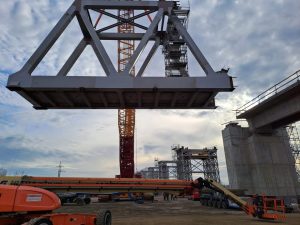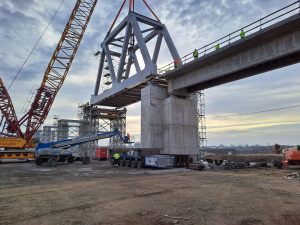After 19 years of closure, an important Romania-Bulgaria rail link will be re-established in spring 2024. Work on the site is currently over 80% complete and the deadline for completion is March 2024, with train services due to resume in April after a month of testing.
In order to understand the importance of this railway, we must first take a brief look at its history. In 1866, the Romanian government signed a contract with the English company John Trevor Barclay & John Staniforth to build a railway from the capital Bucharest to the Danube port of Giurgiu. The railway was put into operation on 19/31 October 1869.
Prince Carol I of Romania advocated at the time the rapid construction of a bridge across the Danube to link the city of Ruse (northern Bulgaria) to Istanbul, while Romania was still under the Ottoman Empire. Due to the low interest in the project, plans begun in 1870 were soon abandoned.
After World War II, the Romanian and Bulgarian governments planned again to build a bridge across the Danube between Giurgiu and Ruse. With Soviet help construction work on the Friendship Bridge began in 1952 and was completed on 20 June 1954.
Grădiștea bridge collapsed in August 2005
Since then, passenger and freight trains ran continuously between the two countries, until 13 August 2005, when the railway bridge over the Argeș river at Grădiștea (southern Romania) was washed away and thus interrupted the movement of trains on the oldest railway in the Romanian Principalities.
Since the collapse of the bridge, the owners of minibus and coach companies that connect the localities along the Bucharest-Giurgiu railway have been making profits they would not otherwise have dared to hope for. On the other hand, trains connecting Romania and Bulgaria have since been diverted to a bypass route. On the direct route, there were 85 km between Bucharest North (the main railway station in Romania’s capital) and Giurgiu North (the border crossing point with Bulgaria). For more than 18 years, since the bypass trains have been running, the distance between the two cities has reached 118 km. As a result, journey times on Regio trains have doubled to almost three hours. As a result, the two pairs of trains still running between Bucharest and Giurgiu (one Regio and the other Interregio, with final destination Ruse, Bulgaria) are mostly empty, with almost exclusively railway employees with free rail passes.
During the summer, trains run from Bucharest to Romania’s southern border, connecting to Sofia and Istanbul. These too have much longer journey times than before the collapse of the bridge at Grădiștea. To make the picture complete, rail freight carriers also have much higher costs because of the detours they have to make. Not to mention the fact that a significant part of the route (between Videle and Giurgiu) is simple and non-electrified, requiring diesel traction and long stopping times at crossings.
Contract worth over EUR 130 million to restore traffic flow
For a decade and a half, the restoration of the rail link between Bucharest and Giurgiu, and further on to Bulgaria, remained at the level of a declaration. It was only on 4 December 2020 that the contract for the infrastructure restoration was signed with the Austrians Porr Construct. The total value of the investment project at the time, including VAT, was over 655 million lei (around EUR 130 million), of which the actual construction-assembly works accounted for over 560 million lei (EUR 110 million). In the meantime, the contract has undergone several successive updates due to rising prices for construction materials, a trend that became apparent after the Covid crisis and Russia’s invasion of Ukraine.
Specifically, Lot 1 of the Bucharest-Giurgiu railway modernisation project, for which the contract with Porr Construct has been signed, involves infrastructure/superstructure works on 12.02 km (Vidra station, from km 18+180 – Comana station, km 30+200), works of art and related works on the entire route.
Four bridges are being rebuilt along the route, the largest of which is the one at Grădiștea, with a total of 35 spans and a length of 1,362.10 m, and ten bridges. The railway route crosses the protected area of Comana Nature Park, for which 10 sub-crossings (type C2) for small mammals and 89 crossing structures (on the track superstructure) for amphibians and reptiles will be built.
As far as new civil constructions are concerned, the Grădiștea and Comana stations should be mentioned. The works that are being carried out involve the replacement of sleepers, changing of rail-track ties, replacement/completion of switches and crossings components, completion of broken stone, replacement of elastic or concrete slabs at level crossings, cleaning of ditches and gullies along the line, etc. The passenger and technical buildings (CED buildings) at all stations and stops along the route were also sanitised – roof repairs, interior and exterior painting, fitting of individual air-conditioning units, addition/replacement of interior and exterior windows/windows, repairs to interior fittings, etc. Also included in the contract are the completion of railway signalling installations and equipment, the completion of railway telecommunications installations and equipment (TTR) and the completion of passenger information installations (audio and video) at all stations and stops along the route.
A special mention should be made about the new Grădiștea railway station. It will no longer be at ground level, but eight metres above, where there will be a single line and a platform, reached by a pedestrian ramp. The project was amended at the request of the Waterways Administration, which kept alive an idea of former communist dictator Nicolae Ceaușescu to introduce steamers on the Argeș river. More precisely, the route of the future Danube-Bucuresti canal was to pass through here, so the bridge over the Argeș river had to be built at a height that would allow ships to pass over the canal.
If the train tracks were at ground level, the construction of the bridge would have required a much lower level of investment, as it would not have required such a long length, so many spans or such a high height of piers.
It should be noted that the old bridge whose construction had begun during the communist period and was then demolished had space for double line, while the one that is now being built will be single line, at the direction of the consultant Jaspers.
Funding provided through the Connecting Europe Facility
Last year, the European Commission announced that 135 transport infrastructure projects were selected for EU grants totalling EUR 5.4 billion. The funding will support post-pandemic economic recovery in all EU Member States, while also helping to build missing transport links across the continent, supporting sustainable transport, improving safety and interoperability and creating jobs.
The selected projects were submitted in response to calls for proposals issued under the Connecting Europe Facility (CEF), the EU’s funding instrument for strategic investments in transport infrastructure, the EC announced. They include phase 1 of the rehabilitation of the Bucharest North-Jilava-Giurgiu North-Giurgiu North-Frontier railway line, reopening rail traffic across the Argeș River between Vidra and Comana, with European funding of EUR 102,056,587.
In the meantime, procedures have also been launched for phase 2 of the four billion lei (EUR 800 million) project, which involves upgrading the entire route between Bucharest and Giurgiu. The project not only provides for the modernisation of the line to increase the speed of traffic to 120 km/hour, but also for the electrification of the line, the implementation of electronic control systems, including ERTMS level 2.
For Lot 2, the feasibility study has been launched, which was carried out by the Baicons Impex (Romania) – Ingenieria Especializada Obra Civil e Industrial (Portugal) partnership.
Share on:







